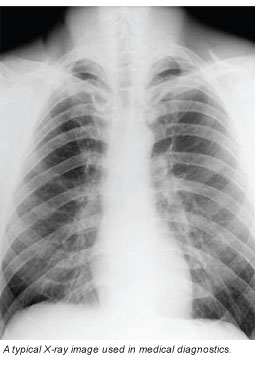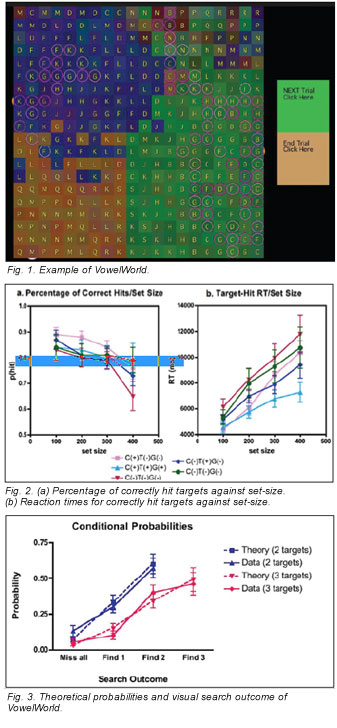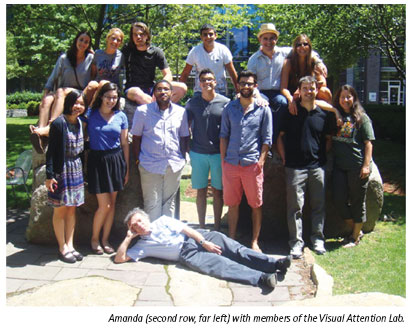|
by Amanda Choo Min Hui and Tan Guoxian
Introduction
In modern medical usage, electroencephalograms (EEG) are typically utilized to record brain waves in clinical neuroscience. While research has been done by countless of others on improving the way brain waves are interpreted on certain types of patients, little or none of these has been directed into the field of epilepsy. EEG data from epilepsy patients are usually transmitted as vast amounts of graphing data from which doctors have to plough through. This requires unnecessary effort and time. In this paper, therefore, we will explore the use of computer graphics as a means of representing and analyzing brain waves recorded by the EEG for epilepsy patients to better aid the scientific community.
 A doctor scrutinizes an X-ray, quickly capturing the shades of grey and white, eyes following the distinct curves of bone and organ. He eventually spots an evasive tumor, and immediately orders a biopsy. The doctor's detection of the tumor could potentially save yet another patient's life. Yet, how many of us can fully appreciate the cognitive processes involved to find such a target? Seventeen-year-old Amanda Choo from Raffles Institution was privileged enough to gain some insights into what influences our visual perception and visual search. A doctor scrutinizes an X-ray, quickly capturing the shades of grey and white, eyes following the distinct curves of bone and organ. He eventually spots an evasive tumor, and immediately orders a biopsy. The doctor's detection of the tumor could potentially save yet another patient's life. Yet, how many of us can fully appreciate the cognitive processes involved to find such a target? Seventeen-year-old Amanda Choo from Raffles Institution was privileged enough to gain some insights into what influences our visual perception and visual search.
Being interested in neuroscience and cognitive psychology, Amanda was naturally very excited when she found out that she was given the opportunity of a lifetime for a summer research internship at Massachusetts Institute of Technology (MIT). Amanda conducted her research project in cognitive psychology at the Visual Attention Lab (Brigham and Women's Hospital, Harvard Medical School) under the mentorship of Prof Jeremy M. Wolfe, Director of the Visual Attention Lab and Professor in Ophthalmology. Moreover, given the almost-complete freedom that her mentor had given her, she was free to explore applications in the real world, allowing her to combine her interests of medicine and psychology in her research.
Cognitive Psychology in Medical Diagnostics
Amanda's research project focused on understanding visual search in medical diagnostics. Medical diagnostics is both a clinical and a visual search problem, where radiologists and doctors need to search and identify a target, such as a fracture in a scene (for example, an X-ray). One challenge that hinders this visual search is satisfaction of search. This is a situation in which the successful detection of one target is reported to interfere with that of other targets, thereby allowing potentially critical underlying complications from being detected. In the field of medical diagnostics, this is a serious problem in which such failures to detect multiple radiographic abnormalities account for an alarmingly high 50% of errors made. Yet, radiologists still do not have access to the workings of visual perception. Hence, the project aims to gain a better understanding of the perceptual processes involved, as well as to develop strategies for improved diagnostic accuracy for patients.
While satisfaction of search may be a problem faced in medicine, studying it directly in the medical context is difficult. For example, radiographic images are difficult to manipulate to produce controlled variables, and studies may not be repeatable. Therefore, Amanda's research proposed a model, VowelWorld as depicted in Figure 1, as a potential model system to rigorously study satisfaction of search. VowelWorld is a complex and rule-governed search task, analogous to reading an X-ray. Non-expert study subjects can also be taught to grasp the guidance rules quickly, similar to radiologists expertise. In addition, rules used to govern visual search in VowelWorld are synonymous with those used in medical diagnostics.
This project has two components. Firstly, single-target searches were studied to understand how the different types of scene guidance affect the accuracy and efficiency of visual search for one vowel. Secondly, multiple-target searches were studied to investigate if satisfaction of search is present, as well as possible causes for the phenomenon.
It was hypothesized that using all rules available in VowelWorld would maximize the efficiency and accuracy of search, rather than relying simply on just one rule alone. Furthermore, it was hypothesized that the conditional probability of detecting a second target, after detecting the first target, would be lower than expected. This is because the study predicted that finding targets that adhered to the semantics and syntax governing VowelWorld during the first detection would shift expectation biases in the participant, thus causing the detection of subsequent targets to be reduced.
The Experiment
 All test subjects were taught the three scene guidance rules in VowelWorld, through verbal explanations and 20 practice trials: the Trail Rule, the Letter Gradient Rule and the Color Rule. They were then given the task to, as quickly and accurately as possible, use these rules to find a vowel within a 20-20 grid and click it to register a "hit". All test subjects were taught the three scene guidance rules in VowelWorld, through verbal explanations and 20 practice trials: the Trail Rule, the Letter Gradient Rule and the Color Rule. They were then given the task to, as quickly and accurately as possible, use these rules to find a vowel within a 20-20 grid and click it to register a "hit".
It was found that combining semantic and syntactic search guidance rules allowed for a significantly more efficient and accurate search, as illustrated in Figure 2. However, the probability of finding subsequent targets was not significantly different from the theoretical probability, if satisfaction did not exist, as shown in Figure 3. In addition, searches with all scene guidance rules turned on are found to be more efficient and accurate. These results provide strong evidence that medical diagnostic tools should employ active multiple scene guidance tools that apply semantics, syntax and episodic scene guidance simultaneously, rather than using them in isolation. The level of adherence to the cues also affects the efficiency of search. When these rules are used in isolation, a target that deviates from the rules is harder to find, as seen in both semantic (color) and syntactic (trail) rules. However, the prevalence of cues both improves and deproves reaction times. Although syntactic rules can aid search, cue prevalence over a certain level is ineffective and possibly counterproductive.
Amanda hopes to further improve VowelWorld and understand how these findings can be tangibly translated into medical diagnostic tools or training. In the event that she becomes a doctor, it will be very exciting to see and understand visual perception firsthand in the medical field.
Reflections of Life at Massachusetts
Selected to represent Singapore to mingle among some of the world's most talented students, Amanda participated in the Research Science Institute, a MOE supported summer research internship program, jointly organized by the Centre for Excellence in Education and MIT. In this program, 80 budding researchers stayed at the MIT campus for six weeks to attend lectures, engage in rigorous research and interact with like-minded individuals from all over the globe.
 For five weeks, she experienced the life of a researcher. Regardless of the number of hours she slept the night before (which ranged from seven hours to one hour), Amanda woke up at the same time each day to munch a few biscuits and began the 10-minute brisk walk to her lab in Cambridge. The day would be spent waiting for test subjects, running experiments on the test subjects, analyzing data, and engaging in discussion with her mentor and other researchers. Lunch times were the best time to have a candid chat with the other researchers about life, or to find out more about their research. By 6 pm, she would repeat the walk (or sometimes, the frenzied run) back to MIT to catch the evening lectures. Despite this routine's intensity, it was an invaluable period of personal growth for Amanda. She learned to be disciplined, persevering and independent as a learner and as a person. She was awed by the talent and passion of her fellow researchers and international friends. The dinner conversations with intelligent yet personable scientists also humbled her and inspired her to strive for similar achievements. For five weeks, she experienced the life of a researcher. Regardless of the number of hours she slept the night before (which ranged from seven hours to one hour), Amanda woke up at the same time each day to munch a few biscuits and began the 10-minute brisk walk to her lab in Cambridge. The day would be spent waiting for test subjects, running experiments on the test subjects, analyzing data, and engaging in discussion with her mentor and other researchers. Lunch times were the best time to have a candid chat with the other researchers about life, or to find out more about their research. By 6 pm, she would repeat the walk (or sometimes, the frenzied run) back to MIT to catch the evening lectures. Despite this routine's intensity, it was an invaluable period of personal growth for Amanda. She learned to be disciplined, persevering and independent as a learner and as a person. She was awed by the talent and passion of her fellow researchers and international friends. The dinner conversations with intelligent yet personable scientists also humbled her and inspired her to strive for similar achievements.
It was truly a unique experience to be able to engage in cognitive psychology research, peer into the minds of others, and gain an intriguing insight into the psychology of how one sees the world. Amanda hopes that other students in her country can also venture beyond their comfort zone and explore the exciting and boundless realms of scientific research. Not only can students challenge themselves cognitively, they also have much to gain from their mentors' wealth of experiences and zest for research and scientific endeavor.
 Click here to download the full issue for USD 6.50 Click here to download the full issue for USD 6.50
|


 A doctor scrutinizes an X-ray, quickly capturing the shades of grey and white, eyes following the distinct curves of bone and organ. He eventually spots an evasive tumor, and immediately orders a biopsy. The doctor's detection of the tumor could potentially save yet another patient's life. Yet, how many of us can fully appreciate the cognitive processes involved to find such a target? Seventeen-year-old Amanda Choo from Raffles Institution was privileged enough to gain some insights into what influences our visual perception and visual search.
A doctor scrutinizes an X-ray, quickly capturing the shades of grey and white, eyes following the distinct curves of bone and organ. He eventually spots an evasive tumor, and immediately orders a biopsy. The doctor's detection of the tumor could potentially save yet another patient's life. Yet, how many of us can fully appreciate the cognitive processes involved to find such a target? Seventeen-year-old Amanda Choo from Raffles Institution was privileged enough to gain some insights into what influences our visual perception and visual search.  All test subjects were taught the three scene guidance rules in VowelWorld, through verbal explanations and 20 practice trials: the Trail Rule, the Letter Gradient Rule and the Color Rule. They were then given the task to, as quickly and accurately as possible, use these rules to find a vowel within a 20-20 grid and click it to register a "hit".
All test subjects were taught the three scene guidance rules in VowelWorld, through verbal explanations and 20 practice trials: the Trail Rule, the Letter Gradient Rule and the Color Rule. They were then given the task to, as quickly and accurately as possible, use these rules to find a vowel within a 20-20 grid and click it to register a "hit". For five weeks, she experienced the life of a researcher. Regardless of the number of hours she slept the night before (which ranged from seven hours to one hour), Amanda woke up at the same time each day to munch a few biscuits and began the 10-minute brisk walk to her lab in Cambridge. The day would be spent waiting for test subjects, running experiments on the test subjects, analyzing data, and engaging in discussion with her mentor and other researchers. Lunch times were the best time to have a candid chat with the other researchers about life, or to find out more about their research. By 6 pm, she would repeat the walk (or sometimes, the frenzied run) back to MIT to catch the evening lectures. Despite this routine's intensity, it was an invaluable period of personal growth for Amanda. She learned to be disciplined, persevering and independent as a learner and as a person. She was awed by the talent and passion of her fellow researchers and international friends. The dinner conversations with intelligent yet personable scientists also humbled her and inspired her to strive for similar achievements.
For five weeks, she experienced the life of a researcher. Regardless of the number of hours she slept the night before (which ranged from seven hours to one hour), Amanda woke up at the same time each day to munch a few biscuits and began the 10-minute brisk walk to her lab in Cambridge. The day would be spent waiting for test subjects, running experiments on the test subjects, analyzing data, and engaging in discussion with her mentor and other researchers. Lunch times were the best time to have a candid chat with the other researchers about life, or to find out more about their research. By 6 pm, she would repeat the walk (or sometimes, the frenzied run) back to MIT to catch the evening lectures. Despite this routine's intensity, it was an invaluable period of personal growth for Amanda. She learned to be disciplined, persevering and independent as a learner and as a person. She was awed by the talent and passion of her fellow researchers and international friends. The dinner conversations with intelligent yet personable scientists also humbled her and inspired her to strive for similar achievements. Click here to download the full issue for USD 6.50
Click here to download the full issue for USD 6.50